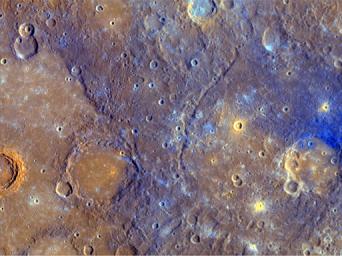
|
A Close-Up View of Mercury’s Colors
- Click the image above for a larger view
- Full-Res JPEG (513 x 384) (48.5 kB)
- Full-Res TIFF (513 x 384) (591.8 kB)
Caption:
After MESSENGER made its closest approach to Mercury, flying just 200 kilometers (124 miles) above the surface, and as soon as the sunlit side of Mercury was fully in view, MDIS captured the highest-resolution color images ever obtained of Mercury (500 meters/pixel (0.3 miles/pixel)). This area was also seen by Mariner 10, whose lower-resolution two-color images hinted at the variety and nature of regions of different colors, and hence composition, on Mercury. Viewed here at high-resolution and in enhanced color, the relationship between the relatively young smooth plains on the left and older, dark blue material on the right is clear. The younger smooth plains cover the lower parts of rougher pre-existing topography and infill older craters, like the 120-kilometer (75-mile) diameter Rudaki crater lower-left of center (see PIA11400 ). Dark, relatively blue material was ejected from the 105-kilometer (65-mile) diameter crater on the right side of the image, covering older smooth plains. A relatively young, small crater then excavated through this blue material to reveal the smooth plains beneath. This scene is centered at 4° South, 310° East and is outlined by a white rectangle on the enhanced color equatorial view of the side of Mercury seen during MESSENGER's second Mercury flyby (see PIA11411 ).
Date Acquired:
October 6, 2008
Instrument:
Wide Angle Camera (WAC) of the Mercury Dual Imaging System (MDIS)
Background Info:
These images are from MESSENGER, a NASA Discovery mission to conduct the first orbital study of the innermost planet, Mercury. For information regarding the use of images, see the MESSENGER image use policy .
Cataloging Keywords:
| Name | Value | Additional Values |
|---|---|---|
| Target | Mercury | |
| System | ||
| Target Type | Planet | |
| Mission | MESSENGER | Mariner |
| Instrument Host | MESSENGER | Mariner 10 |
| Host Type | Orbiter | Flyby Spacecraft |
| Instrument | Mercury Dual Imaging System (MDIS) | |
| Detector | Wide Angle Camera (WAC) | |
| Extra Keywords | Color, Crater | |
| Acquisition Date | ||
| Release Date | 2008-10-30 | |
| Date in Caption | 2008-10-06 | |
| Image Credit | NASA/Johns Hopkins University Applied Physics Laboratory/Carnegie Institution of Washington | |
| Source | photojournal.jpl.nasa.gov/catalog/PIA11410 | |
| Identifier | PIA11410 | |
